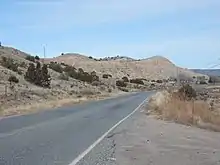Chamita Formation
The Chamita Formation is a geologic formation in north-central New Mexico. It preserves fossils dating back to the Neogene period.[1]
| Chamita Formation Stratigraphic range: Neogene, 13–5.8 Ma | |
|---|---|
 Chamita Formation near the type section, Chamita, New Mexico | |
| Type | Formation |
| Unit of | Santa Fe Group |
| Underlies | Puye Formation |
| Overlies | Tesuque Formation |
| Thickness | 210 metres (690 feet) |
| Lithology | |
| Primary | Sandstone |
| Other | Tuff, siltstone, conglomerate |
| Location | |
| Coordinates | 36.0783°N 106.0864°W |
| Region | New Mexico |
| Country | United States |
| Type section | |
| Named for | Chamita, New Mexico |
| Named by | Galusha and Blick |
| Year defined | 1971 |
 Chamita Formation (the United States)  Chamita Formation (New Mexico) | |
Description
The formation is mostly coarse quartz sandstone with some coarse gravel. It varies greatly in thickness, likely due to extensive erosion.[2]
There are two prominent tuffaceous zones used by Galusha and Blick for regional correlation. Each is about 30 meters (98 feet) thick and they are separated by 80 meters (260 feet) of tan sediments.[3] Radiometric dating shows that the age of the Upper Chamita Tuffaceous Zone is 6.93 ±0.05 million years at its base and 6.78 ±0.03 million years at its top, essentially identical with the Peralta Tuff, which it also chemically resembles. This helps establish the absolute date for the late Hemphillian, since a fossil assemblage of that stage is found in the zone. The Lower Chamita Tuffaceous Zone has a radiometric age of 7.7 ±0.3 million years.[4] The age range for the complete section has been estimated as 9.5 to 5.8 million years.[5] However, more recent work has yielded an age range of 12 to 13 Ma for a Lower Coarse White Ash Zone towards the base of the formation, which is thickest northeast of the Jemez Mountains and has been interpreted as ash fall from early silicic volcanic activity from vents now buried under later flows.[6]
The base of the formation contains sediments resembling the underlying Ojo Caliente Member of the Tesuque Formation. This is interpreted as reworking of sediments in a changed sedimentation environment rather than interfingering.[7]
Members of the formation include the Cejita and Cuarteles Members west of the modern Rio Grande River and the Pilar Mesa, Vallito, and Hernandez Members on both sides of the Rio Grande.[8]
Fossils
The Round Mountain Quarry has produced numerous fossils from the Chamita Formation. The artiodactyl Osbornoceros osborni was first located in the formation in the Lyden area,[1] as was the only known specimen of the taxideine badger, Chamitataxus.[9]
History of investigation
The beds making up the unit were originally included by Bryan and McCann in 1937 in the Middle Red member of the Santa Fe Formation.[10] This became the Tesuque Formation in 1956.[11]
In 1971, Galusha and Blick split the uppermost beds from the Tesuque Formation as the Chamita Formation based on differences in lithology and fossil assemblage.[7]
Footnotes
- Galusha & Blick 1971, p. 76.
- Galusha & Blick 1971, p. 74.
- Galusha & Blick 1971, p. 71.
- McIntosh & Quade 1995.
- Koning & Aby 2005, p. 261.
- Koning et al. 2013.
- Galusha & Blick 1971, p. 7.
- Koning & Aby 2005.
- Owen 2006.
- Bryan & McCann 1937.
- Baldwin 1956, pp. 115-116.
References
- Baldwin, Brewster (1956). "The Santa Fe Group of north-central New Mexico" (PDF). New Mexico Geologic Society Field Conference Series. 7: 115–121. Retrieved 13 May 2020.
- Bryan, Kirk; McCann, Franklin T. (November 1937). "The Ceja Del Rio Puerco: A Border Feature of the Basin and Range Province in New Mexico: I. Stratigraphy and Structure". The Journal of Geology. 45 (8): 801–828. Bibcode:1937JG.....45..801B. doi:10.1086/624608. S2CID 128563355.
- Galusha, Ted; Blick, John C. (1971). "Stratigraphy of the Santa Fe Group, New Mexico" (PDF). Bulletin of the American Museum of Natural History. 144 (1). Retrieved 13 May 2020.
- Koning, Daniel J.; Aby, Scott B. (2005). "Proposed members of the Chamita Formation, north-central New Mexico" (PDF). New Mexico Geological Society Field Conference Series. 56: 258–278. Retrieved 14 May 2020.
- Koning, Daniel J.; Grauch, V. J. S.; Connell, Sean D.; Ferguson, John; McIntosh, William; Slate, Janet L.; Wan, Elmira; Baldridge, W. Scott (1 April 2013). "Structure and tectonic evolution of the eastern Española Basin, Rio Grande rift, north-central New Mexico". New Perspectives on Rio Grande Rift Basins: From Tectonics to Groundwater. doi:10.1130/2013.2494(08). ISBN 9780813724942.
- McIntosh, William C.; Quade, Jay (1995). "40Ar/39Ar geochronology of tephra layers in the Santa Fe Group, Espanola Basin, New Mexico" (PDF). New Mexico Geological Society Guidebook. 46: 279–287. Retrieved 10 August 2020.
- Owen, P.R. (2006). "Description of a new Late Miocene American Badger (Taxidiinae) utilizing high-resolution x-ray computed tomography". Palaeontology. 49 (5): 999–1011. doi:10.1111/j.1475-4983.2006.00590.x.